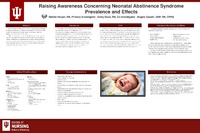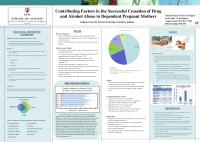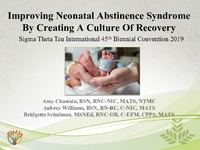Raising awareness concerning neonatal abstinence syndrome prevalence and effects
View File(s)
- Author(s)
- Details
-
Natalie Harper, SN, Indiana University School of Nursing, Indiana University-Purdue University Columbus, Columbus, Indiana, USA; Emily Duke, SN, Indiana University-Purdue University Columbus, Edinburgh, Indiana, USA
- Sigma Affiliation
- Alpha
- Contributor Affiliation(s)
- Indiana University-Purdue University Columbus, Columbus, Indiana, USA
Visitor Statistics
Visits vs Downloads
Visitors - World Map
Top Visiting Countries
| Country | Visits |
|---|
Top Visiting Cities
| City | Visits |
|---|
Visits (last 6 months)
Downloads (last 6 months)
Popular Works for Harper, Natalie by View
| Title | Page Views |
|---|
Popular Works for Harper, Natalie by Download
| Title | Downloads |
|---|
View Citations
Citations
This presentation focuses on the prevalence and associating factors of neonatal abstinence syndrome (NAS). Included is information regarding long-term effects, cost, and contributing factors. Additionally, the viewers will have access to educational material regarding nursing considerations and interventions in relation to caring for patients with NAS.
Leadership Connection 2018: Transformative Nursing Leadership, September 15-18, 2018. Indianapolis, Indiana, USA.
Items submitted to a conference/event were evaluated/peer-reviewed at the time of abstract submission to the event. No other peer-review was provided prior to submission to the Henderson Repository, unless otherwise noted.
| Type | Poster |
| Acquisition | Proxy-submission |
| Review Type | Abstract Review Only: Reviewed by Event Host |
| Format | Text-based Document |
| Evidence Level | N/A |
| Research Approach | N/A |
| Keywords | Clinical Considerations; Drug Epidemic; Neonatal Abstinence Syndrome |
| Name | Leadership Connection 2018 |
| Host | Sigma Theta Tau International |
| Location | Indianapolis, Indiana, USA |
| Date | 2018 |
All rights reserved by the author(s) and/or publisher(s) listed in this item record unless relinquished in whole or part by a rights notation or a Creative Commons License present in this item record.
All permission requests should be directed accordingly and not to the Sigma Repository.
All submitting authors or publishers have affirmed that when using material in their work where they do not own copyright, they have obtained permission of the copyright holder prior to submission and the rights holder has been acknowledged as necessary.
Related items
Showing items related by title, author, creator and subjects.
-
Contributing factors in the successful cessation of drug and alcohol abuse in dependent mothers
Harper, Natalie; Duke, Emily (2017-10-19)This presentation focuses on the factors influencing mothers of newborns to either continue or discontinue use of drugs or alcohol during pregnancy. The desired outcome is to better understand barriers to cessation in hopes ... -
The opposite of addiction is connection: Improving clinical outcomes by implementing NICU peer recovery coaches
Schulman, Bridgette D.Recovering from Substance Use Disorder (SUD) takes more than just treatment. Statistics show a large percentage of the people who are successful in treatment relapse. This highlights the need to focus on long term recovery. ... -
People support what they help to create: Improving clinical outcomes with neonatal abstinence syndrome
Chastain, AmyOur NICU started a journey of interdisciplinary collaboration, employee education standardization, patient care standardization, and peer coaching for the patient families. Throughout our journey we have been able to ... -
Improving clinical outcomes by evolving mindset and creating a culture of hope and recovery
Williams, Aubrey SuzanneIn healthcare, nurses/caregivers have personal bias that can impact the care of patients. How do healthcare workers overcome their bias to provide the best possible care? The journey to improve outcomes for NAS infants has ... -
A model for coordination of a prenatal care clinic for substance abusing pregnant women
Francis, Barbara J. (2015-01-15)Session presented on Thursday, September 25, 2014: The goal of prenatal care is to optimize pregnancy outcomes. Women who use potentially dangerous substances while pregnant present a special concern because prenatal ...





